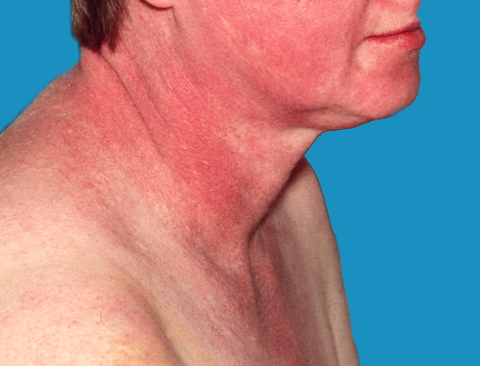Malar rash
Editor-In-Chief: Prab R Tumpati, MD
Obesity, Sleep & Internal medicine
Founder, WikiMD Wellnesspedia &
W8MD medical weight loss NYC and sleep center NYC
| Malar rash | |
|---|---|

| |
| Synonyms | Butterfly rash |
| Pronounce | N/A |
| Specialty | N/A |
| Symptoms | Red or purplish facial rash |
| Complications | May indicate underlying autoimmune disease |
| Onset | Sudden or gradual |
| Duration | Varies, often chronic |
| Types | N/A |
| Causes | Systemic lupus erythematosus, dermatomyositis, rosacea, seborrheic dermatitis, photosensitivity |
| Risks | Sun exposure, genetic predisposition |
| Diagnosis | Clinical evaluation, biopsy, blood tests |
| Differential diagnosis | Rosacea, seborrheic dermatitis, contact dermatitis |
| Prevention | N/A |
| Treatment | Topical corticosteroids, sunscreen, immunosuppressive drugs |
| Medication | N/A |
| Prognosis | N/A |
| Frequency | Common in systemic lupus erythematosus |
| Deaths | N/A |
Malar rash, also known as "butterfly rash," is a medical condition characterized by an erythematous (red) eruption on the central face. This rash typically covers the cheeks and the bridge of the nose, often sparing the nasolabial folds. It is associated with a variety of conditions, ranging from skin disorders to systemic diseases.
Causes[edit | edit source]
Malar rash can be caused by several factors and conditions, including:
- Lupus erythematosus, particularly systemic lupus erythematosus (SLE)
- Rosacea
- Dermatomyositis
- Sun exposure
- Certain medications
- Infections
Symptoms and Characteristics[edit | edit source]
The rash is typically:
- Red or purplish
- Slightly raised
- Painful or itchy in some cases
- Symmetrical over the cheeks and nose
Diagnosis[edit | edit source]
Diagnosis of malar rash involves:
- Clinical examination of the facial skin
- Patient history analysis
- Laboratory tests if systemic lupus erythematosus or other connective tissue diseases are suspected
- Skin biopsy in uncertain cases
Treatment[edit | edit source]
Treatment depends on the underlying cause:
- For lupus-related rash: Corticosteroids or antimalarial medications like hydroxychloroquine
- For rosacea: Topical treatments and avoiding triggers
- For dermatomyositis: Corticosteroids and immunosuppressants
Prevention and Management[edit | edit source]
Preventive measures include:
- Sun protection with broad-spectrum sunscreen
- Avoiding known triggers
- Regular dermatological check-ups for those with chronic conditions
Prognosis[edit | edit source]
The prognosis of malar rash varies greatly depending on its underlying cause. Management of the primary disease often leads to improvement in the rash.
References[edit | edit source]
- Mayo Clinic - Lupus
- American Academy of Dermatology - Rosacea
- American College of Rheumatology - Dermatomyositis
External Links[edit | edit source]
Search WikiMD
Ad.Tired of being Overweight? Try W8MD's physician weight loss program.
Semaglutide (Ozempic / Wegovy and Tirzepatide (Mounjaro / Zepbound) available.
Advertise on WikiMD
|
WikiMD's Wellness Encyclopedia |
| Let Food Be Thy Medicine Medicine Thy Food - Hippocrates |
Translate this page: - East Asian
中文,
日本,
한국어,
South Asian
हिन्दी,
தமிழ்,
తెలుగు,
Urdu,
ಕನ್ನಡ,
Southeast Asian
Indonesian,
Vietnamese,
Thai,
မြန်မာဘာသာ,
বাংলা
European
español,
Deutsch,
français,
Greek,
português do Brasil,
polski,
română,
русский,
Nederlands,
norsk,
svenska,
suomi,
Italian
Middle Eastern & African
عربى,
Turkish,
Persian,
Hebrew,
Afrikaans,
isiZulu,
Kiswahili,
Other
Bulgarian,
Hungarian,
Czech,
Swedish,
മലയാളം,
मराठी,
ਪੰਜਾਬੀ,
ગુજરાતી,
Portuguese,
Ukrainian
Medical Disclaimer: WikiMD is not a substitute for professional medical advice. The information on WikiMD is provided as an information resource only, may be incorrect, outdated or misleading, and is not to be used or relied on for any diagnostic or treatment purposes. Please consult your health care provider before making any healthcare decisions or for guidance about a specific medical condition. WikiMD expressly disclaims responsibility, and shall have no liability, for any damages, loss, injury, or liability whatsoever suffered as a result of your reliance on the information contained in this site. By visiting this site you agree to the foregoing terms and conditions, which may from time to time be changed or supplemented by WikiMD. If you do not agree to the foregoing terms and conditions, you should not enter or use this site. See full disclaimer.
Credits:Most images are courtesy of Wikimedia commons, and templates, categories Wikipedia, licensed under CC BY SA or similar.
Contributors: Kondreddy Naveen, Prab R. Tumpati, MD


